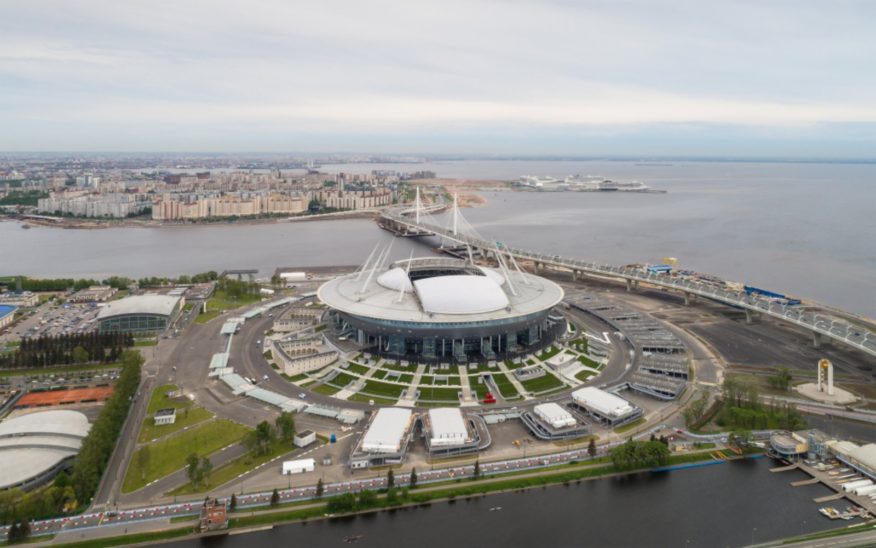
The Jury of Stadium of the Year have released the shortlist of 10 best stadiums opened in 2017. They were selected from a list of 27 nominations by 5 renowned architects, known for their stadium expertise. In order to take part, the voter must select not one but five top stadiums, from the very best (5 stars) to the last best (1 star). The stadium with greatest support will be named Stadium of the Year 2017 on March 7. There are three criteria involved, as described briefly below:

Architectural value: This category includes attractiveness, clarity and consistency of the architecture delivered, as well fitting in local context, both in terms of location and appealing to potential users. Architecture constitutes up to 40% of a stadium’s score.
Functionality: Fit for purpose? This category aim at evaluating whether access, sightlines, protection from elements and acoustics are solved properly, to the extent possible without site visits. Functionality constitutes up to 40% of a stadium’s score.
Innovation: The potential of becoming inspirational to other stadium investors/architects. It may be a set of features, structural or technological solution or even approach to specific challenges. Everything which may contribute to future stadium design can be taken as advantage of the stadium. Innovation constitutes up to 20% of a stadium’s score.
Gaziantep Stadyumu [Gaziantep, Turkey]

Built for a modest amount of $32 million, the new home of Super League team Gaziantepspor is located almost outside the city, in a brand new district being born right now. Located beside a highway, it offers drivers a very captivating impression. As they travel by, the stadium seems to change colours, from black and grey to red. Reached by simple means, this optical illusion catches the eye, while also staying in tune with the team colours of Gaziantepspor. Inside, the 35,000-seat stadium offers a very traditional two-tier auditorium able to hold domestic and international games, even potential Euro, should Turkey win hosting rights.
Luzhniki [Moscow, Russia]

The national stadium of Russia seems almost unchanged outside, but in reality almost nothing was left of the old building. Only the historical yellow brick facades and steel dome on top have been retained, though both these elements have changed. The roof, now covered with PTFE, becomes a giant screen of 30,000 m2 at night thanks to LEDs installed in its cladding. Inside, a brand new seating configuration was created, allowing 81,000 people to watch games comfortably. Building a stadium within the old shell was the largest project of its kind and required very delicate handling. But the outcome is as impressive as a brand new stadium should. Just right for the opening and final of the FIFA World Cup.
Mercedes-Benz Stadium [Atlanta, USA]

Currently the most expensive stadium on earth, priced at massive $1.5 billion. The new home of Atlanta Falcons and brand new team Atlanta United is one of the most technologically advanced sports venues ever built. Its retractable roof is the first of its kind, created with 8 triangular petals seemingly rotating when they open and close. In reality they all travel along straight lines, Equipped with 71,000 seats for Falcons games, the stadium can be downsized with use of curtains for Atlanta United matches. Sharp outer form of the stadium, designed by global brand HOK, is associated to the Falcons symbolism, just like wing-shaped east stand. As if all this wasn’t enough, Mercedes-Benz Stadium became the first ever to receive LEED Platinum certification, proving the emphasis put on sustainability.
Samsun 19 Mayis Stadyumu [Samsun, Turkey]

Placed a long 11-kilometer drive away from the city centre, this new stadium in Northern Turkey is part of an emerging new district. Standing beside a new indoor arena and exhibition centre, catches the eye with curved lines. But, perhaps most importantly, with vast ramp reaching towards spectators in the south, where most fans arrive before games. The stadium pulls people in and once inside, they’re protected from high winds with opaque outer skin. Over 33,000 people can comfortably watch matches of Samsunspor.
Stadion St. Petersburg [St. Petersburg, Russia]

Like a spaceship resting on the mound of old Kirov Stadion, this futuristic stadium in Saint Petersburg has received a fair share of criticism. It took almost 8 years more to build than initially planned, over 7 times more money had to be invested. But once it ‘landed’, Zenit fans settled inside as if at home. A lot of work still needs to be done before Russia’s most expensive stadium ($840 million) can operate properly, but its sliding field and retractable roof indeed make it one of the most advanced stadia ever opened.
Stadion Śląski [Chorzów, Poland]

It was supposed to be part of Euro 2012, but first UEFA dropped it from the list and then a construction accident caused work to stop for 4 long years. It experienced the first ever collapse of a tensile cable roof, which resulted in the budget growing almost twice, to nearly $200 million. But, when finally opened in 2017, it attracted over 100,000 people on opening day! And no wonder, it’s Poland’s most legendary stadium. Now equipped with almost 55,000 blue seats and Europe’s largest roof of its kind, Stadion Śląski sits like a crown within the vast Silesian Park.
Stadionul Ion Oblemenco [Craiova, Romania]

The best stadium in South-Western Romania resembles an egg to some extent. The round body was designed as a landmark for the city of Craiova. It also represents a trend rare in this part of Europe. Rather than being surrounded by tall fences, the stadium welcomes fans with limited fencing and facade gently lifted up, letting sunlight inside the public concourse. Inside it very compact stands for over 30,000 people have been created, sheltered by its impressive dome, rising over 50 meters.
U Arena [Paris/Nanterre, France]

The only rugby stadium on the list and also the only one not to have an open roof. In fact, U Arena is the largest indoor hall across Europe, while serving as a league stadium on weekends. Also selected for the 2024 Olympics, it sits in the famous La Defense area of Nanterre, Paris. Built for almost $440 million, the stadium is covered with 600 smooth scales. Inside it’s divided into two parts. In the south a U-shaped auditorium is created, able to offer capacities from 10,000 to 40,000 depending on occasions all kept in dark colours to create a feeling of cinema-like intimacy. In the north the building changes into over 31,000 m2 of office space, soon to be inhabited by local authorities.
Wanda Metropolitano [Madrid, Spain]

Previously known simply as La Peineta, the stadium used to serve athletics. Then it was part of Madrid’s bid to host the Olympics and finally now it became the long-awaited home for Atletico Madrid. Converted into a 3-tier stadium with almost 68,000 seats, Wanda Metropolitano is covered by one of the world’s most impressive canopies. Though its overall surface is just 46,500 m2, the roof actually uses 83,000 m2 of PTFE due to the way its formed. It seems very fitting that the roof has vibrant nighttime illumination, allowing it to come alive on matchdays.
Yeni Ataturk Stadyumu [Sakarya, Turkey]

Its lightweight and visually flexible structure designed by Alper Aksoy Architects isn’t just dynamic, it’s also reassuring to fans. And that’s not nothing, because Sakaryaspor fans are famour for bouncing up and down while chanting. By far the most exciting part of the stadium is its roof, which makes one forget about the traditional concrete structure beneath. Vast canopy hanging above the stadium is worthy of much greater venue with its total surface 41,500 m2 (including 3,500 m2 of transparent PTFE and remainder in PVC). The transverse axis is 236 meters and the longitudinal axis is 272 meters, while the longest girders span over 70 meters each!
Soure and photos Courtesy of StadiumDB.com.

